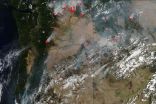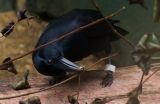(Press-News.org) Howard Hughes Medical Institute (HHMI) scientists have discovered how the most common genetic defect in amyotrophic lateral sclerosis kills nerve cells. Their study suggests that the pores that allow molecules into and out of a cell's nucleus get jammed, a finding that could speed the search for other genes that promote this fatal illness.
In people who have amyotrophic lateral sclerosis (ALS), the motor neurons that operate the muscles deteriorate. Over time, the disease deprives patients of the ability to walk, swallow, and breathe, and they usually die within three to five years.
About 10 percent of ALS cases are hereditary, and researchers have pinpointed about 20 defective genes that can cause the disease. The most common gene variant by far is C9ORF72. The faulty version of this gene contains too many copies of a short DNA segment, known as a repeat. Healthy people usually have 23 or fewer copies of this segment, whereas people who develop ALS can carry hundreds or thousands of duplicates. Extra repeats in the gene also cause frontotemporal dementia (FTD), a disease closely related to ALS.
Researchers haven't discovered how the faulty version C9ORF72 induces nerve cell deterioration. "We want to know what is the primary biological defect that is leading to ALS and FTD," says HHMI Investigator J. Paul Taylor of St. Jude Children's Research Hospital, who led the new study with Fen-Biao Gao of the University of Massachusetts Medical School. The research was published August 26, 2015 in the journal Nature.
To gauge the effects of the repeats, Taylor and Gao's teams turned to fruit flies, which researchers often use to study neurodegenerative diseases such as ALS and FTD. The scientists inserted different numbers of repeats into the insects' chromosomes. When the flies received eight copies of the repeat, they appeared normal. That made sense, Taylor says, since people with that number of repeats don't develop ALS or FTD. But when the flies carried 58 copies of the DNA repeat, they showed signs that cells were damaged and dying. For example, in one experiment the researchers inserted the repeats only into the animals' eyes. In these insects, the normally smooth surface of the eye was ragged, a condition known as rough eye that indicates nerve cells have perished.
Those results showed that the extra repeats poisoned cells in the flies, but they didn't explain how. To try to answer that question, Taylor and colleagues performed a genetic screen. They bred flies that carried 58 repeats in their eyes with many different strains of flies that were missing certain genes. The offspring of these crosses lacked the same genes as their parents, allowing the researchers to determine if a gene's absence affected the insects' eyes. "We looked for something that made the original phenotype better or worse," says Taylor. If the flies had rougher eyes when one of the genes was missing, for example, that gene likely helps prevent the death of neurons. In total, the researchers evaluated the roles of 9,000 different fly genes.
Eighteen of the genes that Taylor and colleagues identified through this procedure were involved in the same cellular function: ferrying molecules into and out of the nucleus through nuclear pores. A membrane encloses the cell's nucleus, and nuclear pores are structures in the membrane that allow certain molecules to pass through. Transportation through the pores is crucial for a cell's survival.
One type of molecule that departs the nucleus through nuclear pores is RNA, which carries the instructions for making proteins and performs other functions outside of the nucleus. The researchers asked whether RNA passed through the pores normally in fly cells with eight or 58 repeats. They discovered that RNA failed to exit appropriately and built up in the nuclei of cells with 58 repeats, suggesting that the nuclear pores weren't working properly in these cells.
The team also measured RNA levels in neurons derived from five people with ALS or FTD who have faulty versions of C9ORF72. Compared with cells from four healthy people, neurons from the patients accumulated about 35 percent more RNA inside the nucleus than outside of it. That finding shows that fly and human cells share the same abnormality, Taylor says.
"This study does not reveal a new drug target, but it does reveal the underlying molecular defect" behind many inherited cases of ALS and FTD, he says. A companion paper in the same issue of Nature supports the conclusion that the extra repeats in C9ORF72 disrupt nuclear pores, Taylor says.
Researchers describe about 90 percent of ALS cases as sporadic because they haven't identified which genes are responsible for the illness. "This finding empowers the search for the genetic causes of sporadic ALS," says Taylor. Now, researchers know what to look for: genes that alter transportation through nuclear pores.
INFORMATION:
A study led by researchers from the U.S. Department of Energy's (DOE) SLAC National Accelerator Laboratory and the University of California, Los Angeles has demonstrated a new, efficient way to accelerate positrons, the antimatter opposites of electrons. The method may help boost the energy and shrink the size of future linear particle colliders - powerful accelerators that could be used to unravel the properties of nature's fundamental building blocks.
The scientists had previously shown that boosting the energy of charged particles by having them "surf" a wave of ionized ...
They're among the most powerful tools for shedding new light on cancer growth and evolution, but mathematical models of the disease for years have faced an either/or stand off.
Though models have been developed that capture the spatial aspects of tumors, those models typically don't study genetic changes. Non-spatial models, meanwhile, more accurately portray tumors' evolution, but not their three-dimensional structure.
A collaboration between Harvard, Edinburgh, and Johns Hopkins Universities including Martin Nowak, Director of the Program for Evolutionary Dynamics ...
New insight into methanotrophs, bacteria that can oxidise methane, may help us develop an array of biotechnological applications that exploit methane and protect our environment from this potent greenhouse gas.
Publishing in Nature, scientists led by Newcastle University have provided new understanding of how methanotrophs are able to use large quantities of copper for methane oxidation.
They have identified a new family of copper storage proteins called Csp that are present in a range of bacteria. These proteins store metal in a way that has not been seen previously ...
It's not a huge mystery why Los Angeles experiences earthquakes. The city sits near a boundary between two tectonic plates -- they shift, we shake. But what about places that aren't along tectonic plate boundaries?
For example, seismicity on the North American plate occurs as far afield as southern Missouri, where earthquakes between 1811 and 1812 estimated at around magnitude 7 caused the Mississippi River to flow backward for hours.
Until now, the cause of that seismicity has remained unclear.
While earthquakes along tectonic plate boundaries are caused by motion ...
The Pacific Northwest is abundantly dotted with wildfires in Washington, Oregon, Idaho and Montana. There are over 27 fires listed in the Inciweb database for the state of Washington. The largest active fire listed is the Okanogan Complex Fire which is currently at 256,567 acres and has 1,250 personnel working the fire. This fire began as a lightning strike on August 15, 2015. It is only 10% contained at present. Governor Inslee's request for a federal Emergency Declaration to provide additional resources to cover some of the costs related to multiple wildfires burning ...
Mostly untouched for 100 years, 15 Roman-era Egyptian mummy portraits and panel paintings were literally dusted off by scientists and art conservators from Northwestern University and the Phoebe A. Hearst Museum of Anthropology as they set out to investigate the materials the painters used nearly 2,000 years ago.
What the researchers discovered surprised them, because it was hidden from the naked eye: the ancient artists used the pigment Egyptian blue as material for underdrawings and for modulating color -- a finding never before documented. Because blue has to be manufactured, ...
UC San Francisco researchers have for the first time developed a method to precisely control embryonic stem cell differentiation with beams of light, enabling them to be transformed into neurons in response to a precise external cue.
The technique also revealed an internal timer within stem cells that lets them tune out extraneous biological noise but transform rapidly into mature cells when they detect a consistent, appropriate molecular signal, the authors report in a study published online August 26 in Cell Systems.
"We've discovered a basic mechanism the cell uses ...
Companies can promote creativity in employees by encouraging them to network beyond their immediate business networks, according to a new study by management experts at Rice University, Australian National University (ANU), Erasmus University Rotterdam, Monash University in Clayton, Australia, and the University of Los Andes in Bogota, Colombia.
"Social networks can be important sources of information and insight that may spark employee creativity," the authors said. "The cross-fertilization of ideas depends not just on access to information and insights through one's ...
CAMBRIDGE, Mass.--For more than a decade, gene sequencers have been improving more rapidly than the computers required to make sense of their outputs. Searching for DNA sequences in existing genomic databases can already take hours, and the problem is likely to get worse.
Recently, Bonnie Berger's group at MIT's Computer Science and Artificial Intelligence Laboratory (CSAIL) has been investigating techniques to make biological and chemical data easier to analyze by, in some sense, compressing it.
In the latest issue of the journal Cell Systems, Berger and colleagues ...
Among our greatest achievements as humans, some might say, is our cumulative technological culture -- the tool-using acumen that is passed from one generation to the next. As the implements we use on a daily basis are modified and refined over time, they seem to evolve right along with us.
A similar observation might be made regarding the New Caledonian crow, an extremely smart corvid and the only non-human species hypothesized to possess its own cumulative technological culture. How the birds transmit knowledge to each other is the focus of a study by Corina Logan, a ...


